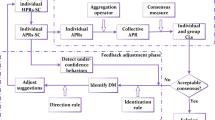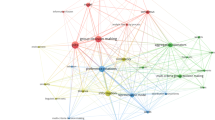Abstract
Due to the promising performance of distribution linguistic preference relations (DLPRs) in eliciting the comparison information coming from decision makers (DMs), linguistic decision problems of this type of preference relations have attracted considerable research interest in recent years. However, to our best knowledge, there is little research on the personalized individual semantics of linguistic terms when dealing with computing with words (CWW) in the process of solving linguistic decision problems with DLPRs. As is well known, one statement about CWW in linguistic decisions is that words might exhibit different meanings for different people. Words need to be individually quantified when dealing with CWW. Hence, the objective of this study is to fill this gap by applying the idea of personalizing numerical scales of linguistic terms for different DMs in linguistic decision with DLPRs to manage the statement about CWW. First, this study connects DLPRs to fuzzy preference relations and multiplicative preference relations by using different types of numerical scales. Then, definitions of expected consistency for DLPRs are presented. On the basis of expected consistency, some goal programming models are built to derive personalized numerical scales for linguistic terms from DLPRs. Finally, a numerical study concerning football player evaluation is analyzed by using the proposed method to demonstrate its applicability in practical decision scenarios. A discussion and a comparative study highlight the validity of the proposed method in this paper.

Similar content being viewed by others
References
Alonso S, Cabrerizo FJ, Chiclana F, Herrera F, Herrera-Viedma E (2009) Group decision making with incomplete fuzzy linguistic preference relations. Int J Intell Syst 24:201–222
Dong YC, Xu YF, Li HY, Dai M (2008) A comparative study of the numerical scales and the prioritization methods in AHP. Eur J Oper Res 186:229–242
Dong YC, Xu YF, Yu S (2009) Linguistic multiperson decision making based on the use of multiple preference relations. Fuzzy Set Syst 160:603–623
Dong YC, Xu YF, Yu S (2009) Computing the numerical scale of the linguistic term set for the 2-tuple fuzzy linguistic representation model. IEEE Trans Fuzzy Syst 17:1366–1378
Dong YC, Zhang GQ, Hong WC, Yu S (2013) Linguistic computational model based on 2-tuples and intervals. IEEE Trans Fuzzy Syst 21:1006–1018
Dong YC, Herrera-Viedma E (2015) Consistency-driven automatic methodology to set interval numerical scales of 2-tuple linguistic term sets and its use in the linguistic GDM with preference relation. IEEE Trans Cybern 45:780–792
Dong YC, Wu YZ, Zhang HJ, Zhang GG (2015) Multi-granular unbalanced linguistic distribution assessments with interval symbolic proportions. Knowl Based Syst 82:139–151
Dong YC, Li CC, Herrera F (2016) Connecting the linguistic hierarchy and the numerical scale for the 2-tuple linguistic model and its use to deal with hesitant unbalanced linguistic information. Inf Sci 367:259–278
Dutta B, Guha D, Mesiar R (2015) A model based on linguistic 2-tuples for dealing with heterogeneous relationship among attributes in multi-expert decision making. IEEE Trans Fuzzy Syst 23:1817–1831
Gao J, Xu ZS, Ren PJ, Liao HC (2018) An emergency decision making method based on the multiplicative consistency of probabilistic linguistic preference relations. Int J Mach Learn Cybern 10:1–17
Ghadikolaei AS, Madhoushi M, Divsalar M (2018) Extension of the VIKOR method for group decision making with extended hesitant fuzzy linguistic information. Neural Comput Appl 30:3589–3602
Gou XJ, Xu ZS, Herrera F (2018) Consensus reaching process for large-scale group decision making with double hierarchy hesitant fuzzy linguistic preference relations. Knowl Based Syst 157:20–33
Herrera-Viedma E, Herrera F, Chiclana F, Luque M (2004) Some issues on consistency of fuzzy preference relations. Eur J Oper Res 154:98–109
Herrera-Viedma E, Martinez L, Mata F, Chiclana F (2005) A consensus support system model for group decision-making problems with multigranular linguistic preference relations. IEEE Trans Fuzzy Syst 13:644–658
Herrera F, Herrera-Viedma E, Verdegay JL (1996) A model of consensus in group decision making under linguistic assessments. Fuzzy Set Syst 78:73–87
Herrera F, Herrera-Viedma E, Martinez L (2000) A fusion approach for managing multi-granularity linguistic term sets in decision making. Fuzzy Set Syst 114:43–58
Herrera F, Herrera-Viedma E, Chiclana F (2001) Multiperson decision-making based on multiplicative preference relations. Eur J Oper Res 129:372–385
Herrera F, Martinez L (2001) A model based on linguistic 2-tuples for dealing with multigranular hierarchical linguistic contexts in multi-expert decision-making. IEEE Trans Syst Man Cybern B Cybern 31:227–234
Herrera F, Alonso S, Chiclana F, Herrera-Viedma E (2009) Computing with words in decision making: foundations, trends and prospects. Fuzzy Optim Decis Mak 8:337–364
Krishankumar R, Ravichandran KS, Ahmed MI, Kar S, Tyagi SK (2019) Probabilistic linguistic preference relation-based decision framework for multi-attribute group decision making. Symmetry 11:2
Li CC, Dong YC, Herrera F, Herrera-Viedma E, Martinez L (2017) Personalized individual semantics in computing with words for supporting linguistic group decision making. An application on consensus reaching. Inf Fusion 33:29–40
Li CC, Rodríguez RM, Herrera F, Martinez L, Dong YC (2017) A consistency-driven approach to set personalized numerical scales for hesitant fuzzy linguistic preference relations. In: IEEE international conference on fuzzy systems (FUZZ-IEEE), Naples, Italy. IEEE, pp 1–5
Li CC, Rodriguez RM, Martinez L, Dong YC, Herrera F (2018) Personalized individual semantics based on consistency in hesitant linguistic group decision making with comparative linguistic expressions. Knowl Based Syst 145:156–165
Liu HB, Ma Y, Jiang L (2019) Managing incomplete preferences and consistency improvement in hesitant fuzzy linguistic preference relations with applications in group decision making. Inf Fusion 51:19–29
Martinez L, Herrera F (2012) An overview on the 2-tuple linguistic model for computing with words in decision making: extensions, applications and challenges. Inf Sci 207:1–18
Massanet S, Riera JV, Torrens J, Herrera-Viedma E (2016) A model based on subjective linguistic preference relations for group decision making problems. Inf Sci 355:249–264
Mendel JM, Wu D (2010) Perceptual computing: aiding people in making subjective judgments. IEEE Press and John Wiley, New Jersey
Mendel JM, Zadeh LA, Trillas E, Yager R, Lawry J, Hagras H, Guadarrama S (2010) What computing with words means to me. IEEE Comput Intell Mag 5:20–26
Morente-Molinera JA, Perez IJ, Urena MR, Herrera-Viedma E (2015) On multi-granular fuzzy linguistic modeling in group decision making problems: a systematic review and future trends. Knowl Based Syst 74:49–60
Ölçer Aİ, Odabaşi AY (2005) A new fuzzy multiple attributive group decision making methodology and its application to propulsion/manoeuvring system selection problem. Eur J Oper Res 166:93–114
Pang Q, Wang H, Xu ZS (2016) Probabilistic linguistic linguistic term sets in multi-attribute group decision making. Inf Sci 369:128–143
Rodriguez RM, Martinez L, Herrera F (2013) A group decision making model dealing with comparative linguistic expressions based on hesitant fuzzy linguistic term sets. Inf Sci 241:28–42
Saaty TL (1980) The analytic hierarchy process. McGraw-Hill, New York
Salo AA, Hämäläinen RP (1997) On the measurement of preferences in the analytic hierarchy process. J Multi-Criteria Decis Anal 6:309–319
Tanino T (1984) Fuzzy preference orderings in group decision-making. Fuzzy Set Syst 12:117–131
Wang JH, Hao JY (2006) A new version of 2-tuple. Fuzzy linguistic, representation model for computing with words. IEEE Trans Fuzzy Syst 14:435–445
Wang JH, Hao J (2007) An approach to computing with words based on canonical characteristic values of linguistic labels. IEEE Trans Fuzzy Syst 15:593–604
Wu YZ, Li CC, Chen X, Dong YC (2018) Group decision making based on linguistic distributions and hesitant assessments: maximizing the support degree with an accuracy constraint. Inf Fusion 41:151–160
Wu ZB, Xu JP (2016) Managing consistency and consensus in group decision making with hesitant fuzzy linguistic preference relations. Omega Int J Manag S 65:28–40
Xu JP, Wu ZB (2013) A maximizing consensus approach for alternative selection based on uncertain linguistic preference relations. Comput Ind Eng 64:999–1008
Xu ZS (1999) Study on the relation between two classes of scales in AHP. Syst Eng Theory Pract 19:311–314
Xu ZS (2004) EOWA and EOWG operators for aggregating linguistic labels based on linguistic preference relations. Int J Uncertain Fuzz 12:791–810
Xu ZS (2007) A survey of preference relations. Int J Gen Syst 36:179–203
Xu ZS (2008) Group decision making based on multiple types of linguistic preference relations. Inf Sci 178:452–467
Zadeh LA (1975) The concept of a linguistic variable and its application to approximate reasoning. 1. Inf Sci 8:199–249
Zhang BW, Liang HM, Gao Y, Zhang GQ (2018) The optimization-based aggregation and consensus with minimum-cost in group decision making under incomplete linguistic distribution context. Knowl Based Syst 162:92–102
Zhang GQ, Dong YC, Xu YF (2014) Consistency and consensus measures for linguistic preference relations based on distribution assessments. Inf Fusion 17:46–55
Zhang YX, Xu ZS, Wang H, Liao HC (2016) Consistency-based risk assessment with probabilistic linguistic preference relation. Appl Soft Comput 49:817–833
Zhang YX, Xu ZS, Liao HC (2017) A consensus process for group decision making with probabilistic linguistic preference relations. Inf Sci 414:260–275
Zhang YX, Xu ZS, Liao HC (2018) An ordinal consistency-based group decision making process with probabilistic linguistic preference relation. Inf Sci 467:179–198
Zhang Z, Guo CH, Martinez L (2017) Managing multigranular linguistic distribution assessments in large-scale multiattribute group decision making. IEEE Trans Syst Man Cybern Syst 47:3063–3076
Zhang ZM, Wu C (2014) On the use of multiplicative consistency in hesitant fuzzy linguistic preference relations. Knowl Based Syst 72:13–27
Acknowledgements
This research was supported by the State Scholarship Fund of China (No. 201706690025), the Foundation for Innovative Research Groups of the Natural Science Foundation of China (No. 71521001) and the National Natural Science Foundation of China (Nos. 71690230, 71690235, 71501056, 71601066, 71501055, 71501054 and 71571166).
Author information
Authors and Affiliations
Corresponding author
Ethics declarations
Conflicts of interest
The authors declare that there is no conflict of interest regarding the publication of this paper.
Additional information
Publisher's Note
Springer Nature remains neutral with regard to jurisdictional claims in published maps and institutional affiliations.
Rights and permissions
About this article
Cite this article
Tang, X., Zhang, Q., Peng, Z. et al. Derivation of personalized numerical scales from distribution linguistic preference relations: an expected consistency-based goal programming approach. Neural Comput & Applic 31, 8769–8786 (2019). https://doi.org/10.1007/s00521-019-04466-5
Received:
Accepted:
Published:
Issue Date:
DOI: https://doi.org/10.1007/s00521-019-04466-5




